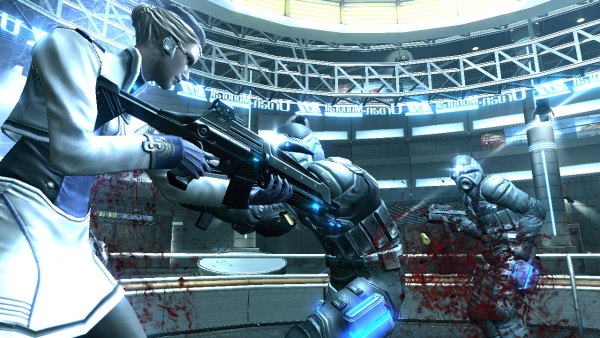
Ever since Square Enix teamed up to publish games by other developers, the quality of the company’s branded output hasn’t been quite the same. This logic is proven with the recent release of developer FeelPlus’ title Mindjack. The attempt to make it a unique multiplayer shooter was well-intentioned, but once Mindjack is put to the test, it crawls like a handicapped, elderly secret agent.
Platforms: PS3, Xbox 360 (Version Played)
Publisher: Square Enix
Developer: FeelPlus
Genre: Headache-Inducing Third-Person Shooter
Release Date: January 18, 2011
ESRB Rating: Mature
Mindjack starts to topple over from the beginning, where no sense of story is given aside from the vague scenario of “everyone is coming to kill you because something has gone wrong.” Even throughout the game, little detail is given in the plot, which oddly finishes with a questionably unintentional similarity to the first Resident Evil movie. Mindjack’s FIA (Federal Intelligence Agency) agent and protagonist Jim Korbijn is initially armed with a pistol and the most basic of what I’ll dub “hacking powers.” The pre-campaign tutorial educates newbies on the use of these interesting powers, but implementing a specific tutorial seemed unnecessary, considering the small amount learned from it. The powers make the beginning of the game a good amount of fun, though. Not only were they fairly gratifying, using them on enemies issued a decent amount of experience points to ol’ Jimmy K.
Speaking more about experience points, Mindjack uses an experience/leveling system loosely based on Call of Duty’s multiplayer, where kills grant you a base amount of experience, and special kills (including the use of Korbijn’s hacking powers) grant you additional experience points. Leveling happens automatically throughout the game, making it feel like a pointless system to incorporate. As if you’d want to play more, you can’t “grind” enemies for more experience, because the game only dumps out a certain amount through the story before making you press on. Though the leveling system does offer players a few ability perks – or “plug-ins” and “arts” as the game calls them – they don’t seem to help Korbijn’s cause in the campaign. Furthermore, the game requires a return to its title screen in order for the player to equip these questionably supportive power-ups, forcing them to temporarily abort their progress in the campaign. The entire selection of plug-ins is limited to roughly 15, and the game’s selection of designated “arts” is limited to less than ten, the latter only being beneficial in the online multiplayer experience.
Mindjack’s multiplayer offering isn’t a particularly successful one; it seemed extremely tacked on, as no maps were specifically designed for the game’s multiplayer mode. This “mode” – if you can really feel good about calling it that – allows players to hack into the single player campaigns of others and bug the hell out of them, for a lack of better words. Although the game does give campaign-wanderers the option to screen out incoming hackers, many players will likely fly through that dialog box, accidentally permitting the annoyance that is Mindjack’s multiplayer. Once in, these hackers are automatically assigned to the blue or red team. The idea of teams simply gives human players the opportunity to overtake the enemy AIs’ spots, adding a bit more challenge to the campaign for those who want it. Actually, this adds a LOT more challenge. When I was only a level 20 hacker, I was unfortunate enough to have a level 65 player hack into my game and completely disembowel any chance I had of getting past the current stage. Simply put, the multiplayer is a pointless option to make available until players have at least finished the game, unless you are a sadist, which you’d have to be to pay money for this “experience.”

The game’s controls in the multiplayer and single player modes are identical, and can occasionally be awkward. Characters move slowly unless they are dashing about in combat, and the cover system can be a frustrating experience. Through the beginning of the game, it is left up to the player to discover most of the game’s essential controls, making even the most hardened gamer paranoid, thinking that they may be unknowingly missing out on vital combat mechanics. The aiming system works fine, though; crosshairs are fairly accurate, and players aren’t left spraying bullets at enemies unless they are completely out of range. Don’t expect to get any long-distance shotgun headshots.
Eventually though, most players will catch on to how Mindjack’s combat works, mainly because combat is the only thing players will encounter in the game. When embarrassingly discussing Mindjack with friends, I describe it as “an on-rails shooter with its rails detached,” mostly because low-incentive, tedious room-to-room shooting makes up 85% of the game. Although it is a fairly generic third-person shooter, Mindjack’s intentions regarding unique combat were in the right place. Unfortunately, mechanics were poorly executed, as Korbijn’s “Mind Slave” ability allows crappy, weakened enemy AI to join your side, becoming crappy friendly AI. It still helps by lowering the enemy count, but an enslaved AI attempting to use melee attacks on a squad of gun-firing enemies is particularly ineffective.
Aside from the issues with the AI, several other combat issues exist. Boss fights don’t take long to complete towards the beginning of the game, but as players progress through the campaign, some fights can take upwards of 45 minutes. Throughout most of these elongated fights, little notice of impending victory is given, driving an onslaught of FAQ threads on the game’s now-infamous “Mech-type” boss, who appears towards the end. One particular glitchy incident occurred when I was fighting against a boss in one of the final segments of the game; after using all of the room’s available ammunition on the boss’ face, my team was left with no means of fighting. The boss regurgitated my already-useless melee attacks back on me. I wondered whether all of this was intentional. I tried this fight again and ended in success, but it was a bad sign when I wasn’t surprised by how ungodly lengthy the first erroneous encounter was.
Not only can boss fights be grueling endurance matches, the game is extremely unforgiving in letting the player recuperate during these bouts because of the lack of a true “pause” state. Players can pause the game to adjust options or return to the title screen, but pressing start won’t actually pause the game. Korbijn (or the currently active character you’re playing as) can still take damage and be killed, rendering the pause menu useless from the get-go. There is also no mini-map available to the player, forcing a full-on visual search for every enemy in any given area. This is especially frustrating in boss battles. Even if a boss is defeated, the fight doesn’t end until the game’s required number of regular goons have spawned and been killed.
I wanted to like Mindjack. I hadn’t heard much pre-release buzz about it, and now I see why. It reminded me of the next iteration of Psi Ops – a commonly overlooked personal favorite. Unfortunately, Mindjack was more limited in its functionality and its total offering, but it still captured a taste of what Psi Ops had. Mindjack also borrowed a lot of elements from games like Mass Effect, Gears of War, and Resident Evil, but FeelPlus just wasn’t in it to win it on this one. I will say that through the beginning of the game, I had a hard time putting the controller down because I was so enthused by my initial impressions. But the tedious repetition of gunfire combat in addition to less-than-desirable mechanics quickly made me hungry for a different game to play.

Review Disclosure: A review copy of Mindjack was provided by Square Enix for the purposes of this review.







